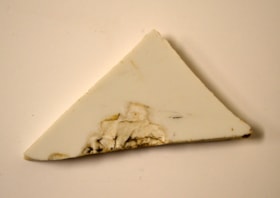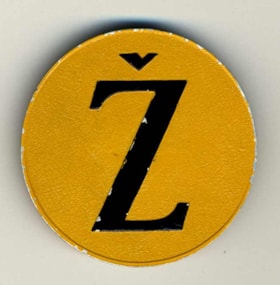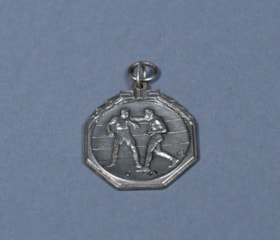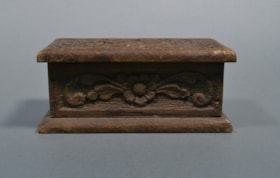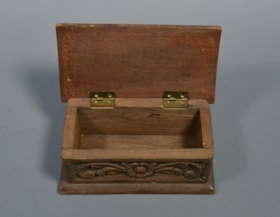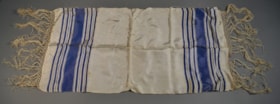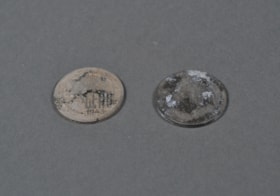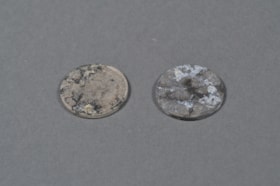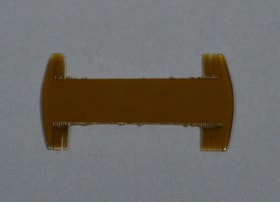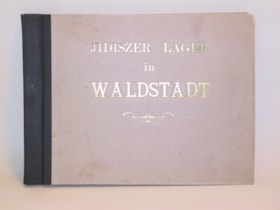Narrow Results By
Collection
- A. L. Florence fonds 1
- A. Nissenson Fonds 1
- ABER, Ita 1
- Abe Hochberg fonds 1
- Abelson family fonds 1
- Abraham Caplin fonds 1
- Adath Jeshurun Congregation Fonds 3
- Adath Jeshurun Congregation fonds 6
- Aline Gubbay Fonds 1
- Anchel, Gotlieb, and Gilbert families = Montreal Jewish leisure and school activities 1
- Applebaum-Bodovsky Family Fonds 2
- Archibald and Lillian Freiman family fonds 21
Place
- Africa 1
- Ainring, Germany, Europe 1
- Amsterdam, Holland, Holland 1
- Amsterdam, Netherlands, Europe 8
- Athlit, Palestine, Asia 1
- Auschwitz; Belsen (death march), Poland, Germany, Europe 1
- Auschwitz-Birkenau, Poland, Europe 2
- Auschwitz, Poland, Europe 3
- Austria, Europe 2
- Baden-Baden, Germany, Europe 1
- Balassagyarmat, Hungary, Europe 4
- Belarus, Europe 2
Subject
- Baron de Hirsh Institute, Montreal. 4
- Benditsky Family Fonds 1
- Bergen Belsen (Germany: Concentration camp) 3
- Bergen-Belsen Survivors Association 3
- Cameron, Angus, 1885-1952 1
- Canadian Jewish Congress 1
- Charitable organization 2
- Children - Jewish 1
- Clothing and dress. 18
- Costumes 1
- Dinovitzer, Bertha, 1878-1965 1
- Displaced persons 3
Tile fragment
https://www.cjhn.ca/link/cjhn45710
- Collection
- Montreal Holocaust Museum
- Description Level
- Item
- Material Type
- object
- Physical Description
- Tile fragment : printed : white, black ; Ht: 5,2 cm x W: 4,5 cm
- Date
- 1941-1944
- Collection
- Montreal Holocaust Museum
- Description Level
- Item
- Material Type
- object
- Physical Description
- Tile fragment : printed : white, black ; Ht: 5,2 cm x W: 4,5 cm
- Other Title Information
- Artifact Remnant
- Date
- 1941-1944
- Physical Condition
- Poor
- Notes
- Small triangular fragment of white ceramic tile showing the Reichsadler printed in black. Narrative: Found on the site of Stalag XII F sub-camp Johannis-Bannberg (Ban Saint-Jean) by local historian Gabriel Becker. An estimated 22,000 Soviet prisoners of war died there of malnutrition and exhaustion between 1941-1944.
- Accession No.
- 2011.374.02
- Name Access
- Silès, Damien
- Places
- Europe
- Archival / Genealogical
- Archival Descriptions
- Repository
- Montreal Holocaust Museum
Images
Bullet
https://www.cjhn.ca/link/cjhn45711
- Collection
- Montreal Holocaust Museum
- Description Level
- Item
- Material Type
- object
- Physical Description
- Bullet : cast : brown-red ; Ht: 5,7 cm x W: 1 cm
- Date
- 1941-1944
- Collection
- Montreal Holocaust Museum
- Description Level
- Item
- Material Type
- object
- Physical Description
- Bullet : cast : brown-red ; Ht: 5,7 cm x W: 1 cm
- Other Title Information
- Armament T&E, Ammunition
- Date
- 1941-1944
- Physical Condition
- Poor
- Notes
- Circular bullet casing, empty. Narrative: Found on the site of Stalag XII F sub-camp Johannis-Bannberg (Ban Saint-Jean) by local historian Gabriel Becker. An estimated 22,000 Soviet prisoners of war died there of malnutrition and exhaustion between 1941-1944.
- Accession No.
- 2011.374.03
- Name Access
- Silès, Damien
- Places
- Europe
- Archival / Genealogical
- Archival Descriptions
- Repository
- Montreal Holocaust Museum
Images
Ring
https://www.cjhn.ca/link/cjhn45712
- Collection
- Montreal Holocaust Museum
- Description Level
- Item
- Material Type
- object
- Physical Description
- Ring : cut, soldered, forged, openworked : silver ; Ht: 6,5 cm x W: 5 cm x De: 5 cm
- Collection
- Montreal Holocaust Museum
- Description Level
- Item
- Material Type
- object
- Physical Description
- Ring : cut, soldered, forged, openworked : silver ; Ht: 6,5 cm x W: 5 cm x De: 5 cm
- Other Title Information
- Adornment
- Physical Condition
- Good
- Notes
- Ring is surmounted by 2 Stars of David, which, in turn, are separated by a round piece of metal. A hinge is attached between the 2 stars, and opens to reveal an inner compartment. Each Star of David has braided detailings along the edge. A structure is sitting on top of the top star, which has 3 openings on the sides. It is topped by a dome, with openworked detailing of lines and holes. Narrative: An ornate ring that was used during a Jewish wedding ceremony. It is thought to be a communal wedding ring, used by different members of the community during wedding services. The bride's own wedding band would be enclosed in this communal ring.
- Accession No.
- 2011.375.01
- Name Access
- Ponti-Hill, Barbara
- Places
- Europe
- Archival / Genealogical
- Archival Descriptions
- Repository
- Montreal Holocaust Museum
Images
Identification badge
https://www.cjhn.ca/link/cjhn45741
- Collection
- Montreal Holocaust Museum
- Description Level
- Item
- Material Type
- object
- Physical Description
- Identification badge : Yellow, Black
- Date
- 1941-1945
- Collection
- Montreal Holocaust Museum
- Description Level
- Item
- Material Type
- object
- Physical Description
- Identification badge : Yellow, Black
- Other Title Information
- Personal Symbol
- Date
- 1941-1945
- Physical Condition
- Good
- Language
- Serbo-Croatian
- Notes
- Circular badge with raised edges. Narrative: By 30 April 1941, all Jews in Croatia were ordered by the Ustaše government to wear this badge. Donor was exempt, because his mother was Christian. The Svarc (Schwarz) family were liberated by Yugoslav partisans in Zagreb 1944. After the war, Dr. Djuro Svarc (born in Koprivnica) kept it, then gave it to his son Emile, who brought it to Canada.
- Accession No.
- 1981.01.01
- Name Access
- Svarc, Emile
- Places
- Zagreb, Croatia, Europe
- Archival / Genealogical
- Archival Descriptions
- Repository
- Montreal Holocaust Museum
Images
Sock
https://www.cjhn.ca/link/cjhn45742
- Collection
- Montreal Holocaust Museum
- Description Level
- Item
- Material Type
- object
- Physical Description
- Sock : woven, knitted, sewn, machine, embroidered : grey, beige, blue, orange, pink
- Date
- 1939-1943
- Collection
- Montreal Holocaust Museum
- Description Level
- Item
- Material Type
- object
- Physical Description
- Sock : woven, knitted, sewn, machine, embroidered : grey, beige, blue, orange, pink
- Other Title Information
- Clothing, Footwear
- Date
- 1939-1943
- Physical Condition
- Good
- Notes
- Grey socks with beige stripes and tops. Embroidered detailing and reinforcement is found along the sole and heels. Socks worn in hiding in Zagreb. Narrative: Donor's father was in camp in Croatia, but was released due to the efforts of his wife who was not Jewish. She managed to influence a policeman to release her husband. He then went to Zagreb and remained in hiding there, during which time he wore and mended these socks. Socks worn in hiding in Zagreb.
- Accession No.
- 1981.01.02-03
- Name Access
- Svarc, Emile
- Places
- Zagreb, Croatia, Europe
- Archival / Genealogical
- Archival Descriptions
- Repository
- Montreal Holocaust Museum
Images
Tefillin
https://www.cjhn.ca/link/cjhn45743
- Collection
- Montreal Holocaust Museum
- Description Level
- Item
- Material Type
- object
- Physical Description
- Tefillin : moulded, knotted, sewn, painted, glued : black, brown, beige ; Ht: 6 cm x W: 8 cm x De: 6 cm
- Date
- [Prior to 1938]
- Collection
- Montreal Holocaust Museum
- Description Level
- Item
- Material Type
- object
- Physical Description
- Tefillin : moulded, knotted, sewn, painted, glued : black, brown, beige ; Ht: 6 cm x W: 8 cm x De: 6 cm
- Other Title Information
- Ceremonial Artifact
- Date
- [Prior to 1938]
- Physical Condition
- Good
- Notes
- Shel Rosh: Black painted box on a flat, square, base. The base is made of multiple layers that have been stitched together. The box has 3 grooves on the top and 2 of the sides, with Hebrew characters on the other 2 sides (see inscription). A leather strap passes through the base, forming a band, and is knotted together in the middle, with the ends hanging loose. Narrative: Simon (Shimon) Markel was given these tefiliin by his mother as he was leaving Poland as part of the Kindertransport. He was born March 23, 1923 to Ferdinand and Anna Markel. He had three brothers. Simon's family was originally from Chemnitz, Germany. The boys went to Jewish school and their house was kept kosher. They were relocated to Poland after the Nazis rose to power. Simon was selected for the Kindertransport; he was the only member of his family to be able to escape Poland. His parents and three brothers were killed in Auschwitz. Simon spent some time studying, then spent time in England before being interned as a German citizen. He was sent to Fort Lennox internment camp on Île-aux-Noix, Canada; he arrived on the boat Sobieski. Simon became an engineer in Canada.
- Accession No.
- 2011.28.01
- Name Access
- Markel, Miriam
- Places
- Poland, Europe
- Archival / Genealogical
- Archival Descriptions
- Repository
- Montreal Holocaust Museum
Images
Tefillin
https://www.cjhn.ca/link/cjhn45744
- Collection
- Montreal Holocaust Museum
- Description Level
- Item
- Material Type
- object
- Physical Description
- Tefillin : moulded, knotted, sewn, painted : black, brown, beige ; Ht: 6 cm x W: 8 cm x De: 6 cm
- Date
- [Prior to 1938]
- Collection
- Montreal Holocaust Museum
- Description Level
- Item
- Material Type
- object
- Physical Description
- Tefillin : moulded, knotted, sewn, painted : black, brown, beige ; Ht: 6 cm x W: 8 cm x De: 6 cm
- Other Title Information
- Ceremonial Artifact
- Date
- [Prior to 1938]
- Physical Condition
- Good
- Notes
- Shel Yad: Black painted box on a flat, square, base. The base is made of multiple layers that have been stitched together. A leather strap passes through a leather loop on the reverse of the base, which allows the strap to be looped into itself and adjusted for size. Narrative: Simon (Shimon) Markel was given these tefiliin by his mother as he was leaving Poland as part of the Kindertransport. He was born March 23, 1923 to Ferdinand and Anna Markel. He had three brothers. Simon's family was originally from Chemnitz, Germany. The boys went to Jewish school and their house was kept kosher. They were relocated to Poland after the Nazis rose to power. Simon was selected for the Kindertransport; he was the only member of his family to be able to escape Poland. His parents and three brothers were killed in Auschwitz. Simon spent some time studying, then spent time in England before being interned as a German citizen. He was sent to Fort Lennox internment camp on Île-aux-Noix, Canada; he arrived on the boat Sobieski. Simon became an engineer in Canada.
- Accession No.
- 2011.28.02
- Name Access
- Markel, Miriam
- Places
- Poland, Europe
- Archival / Genealogical
- Archival Descriptions
- Repository
- Montreal Holocaust Museum
Images
Medal
https://www.cjhn.ca/link/cjhn45880
- Collection
- Montreal Holocaust Museum
- Description Level
- Item
- Material Type
- object
- Physical Description
- Medal : moulded, stamped, embossed, engraved : grey, silver
- Date
- August 15, 1934
- Collection
- Montreal Holocaust Museum
- Description Level
- Item
- Material Type
- object
- Physical Description
- Medal : moulded, stamped, embossed, engraved : grey, silver
- Other Title Information
- Personal Symbol
- Date
- August 15, 1934
- Physical Condition
- Good
- Notes
- Apple shaped medal from the Olympia Club. Side and the top edges are smooth; the bottom edge is following the shape of the wreath and bow that is embossed on the surface. The centre of the medal has a raised circle, in a dotted border and the image of a man flexing his arms in the centre. There are two curlicues following the side edges, curling at the top on either side. Attached at the top centre is a round metak sphere with a hole in the middle, with a metak ring going through. Smooth back with inscription. Boxing medal from the Olympia sporting club Narrative: Medal was won by donor, David Kropveld. David Kropveld was born on January 3, 1918, in Amsterdam, Holland. David took up boxing as a young man and participated in competitions. In July 1940, David and his father joined the White Brigade resistence group in the south of France. As members of the White Brigade, David and his father gave up their Jewish identities. In October 1942, David was arrested while smuggling war-related information between occupied and Vichy France. He was tortured for ten days before being released. He was reunited with his father in Brussels, but the two were arrested by Gestapo officers one week later. They were incarcerated for three months and deported to Auschwitz concentration camp (Poland). Father and son wore the badges of political prisoners and were selected for the slave labour camp of Monowitz, where they stayed for about five days prior to being transferred to camp of Treblinka (Poland). In Treblinka, David witnessed his father’s murder at the hands of a guard. In the fall of 1944, a guard recognized David as a boxer he had admired and had him transferred back to Auschwitz and Monowitz in December 1944 to compete boxing matches against other prisoners. In December 1944, David managed to escape the death march with a few iother prisoners. He was rescued shortly after and brought to a hospital until his health improved. No members of his family survived the war. In the summer of 1945, David met his wife. In 1947, the couple emigrated to Cuba, and in 1950, to Montreal where David began a successful career as a butcher.
- Accession No.
- 1990.83.19
- Name Access
- Kropveld, David
- Places
- Charleroi ?, Belgium, Europe
- Archival / Genealogical
- Archival Descriptions
- Repository
- Montreal Holocaust Museum
Images
Medal
https://www.cjhn.ca/link/cjhn45881
- Collection
- Montreal Holocaust Museum
- Description Level
- Item
- Material Type
- object
- Physical Description
- Medal : moulded, stamped, embossed, engraved : gold
- Date
- 1936
- Collection
- Montreal Holocaust Museum
- Description Level
- Item
- Material Type
- object
- Physical Description
- Medal : moulded, stamped, embossed, engraved : gold
- Other Title Information
- Personal Symbol
- Date
- 1936
- Physical Condition
- Good
- Notes
- Cross-shaped medal from the Olympia boxing club, with a circle in the centre and coming out if the cross arms. The centre circle has an image of two men boxing. An eye is attached to the top arm of the cross, centre with a metal ring going through. The back is smooth and has an inscription. Narrative: Medal was won by donor, David Kropveld. David Kropveld was born on January 3, 1918, in Amsterdam, Holland. David took up boxing as a young man and participated in competitions. In July 1940, David and his father joined the White Brigade resistence group in the south of France. As members of the White Brigade, David and his father gave up their Jewish identities. In October 1942, David was arrested while smuggling war-related information between occupied and Vichy France. He was tortured for ten days before being released. He was reunited with his father in Brussels, but the two were arrested by Gestapo officers one week later. They were incarcerated for three months and deported to Auschwitz concentration camp (Poland). Father and son wore the badges of political prisoners and were selected for the slave labour camp of Monowitz, where they stayed for about five days prior to being transferred to camp of Treblinka (Poland). In Treblinka, David witnessed his father’s murder at the hands of a guard. In the fall of 1944, a guard recognized David as a boxer he had admired and had him transferred back to Auschwitz and Monowitz in December 1944 to compete boxing matches against other prisoners. In December 1944, David managed to escape the death march with a few iother prisoners. He was rescued shortly after and brought to a hospital until his health improved. No members of his family survived the war. In the summer of 1945, David met his wife. In 1947, the couple emigrated to Cuba, and in 1950, to Montreal where David began a successful career as a butcher.
- Accession No.
- 1990.83.25
- Name Access
- Kropveld, David
- Places
- Charleroi ?, Belgium, Europe
- Archival / Genealogical
- Archival Descriptions
- Repository
- Montreal Holocaust Museum
Images
Medal
https://www.cjhn.ca/link/cjhn45882
- Collection
- Montreal Holocaust Museum
- Description Level
- Item
- Material Type
- object
- Physical Description
- Medal : moulded, stamped, embossed, engraved : silver
- Date
- 1941
- Collection
- Montreal Holocaust Museum
- Description Level
- Item
- Material Type
- object
- Physical Description
- Medal : moulded, stamped, embossed, engraved : silver
- Other Title Information
- Personal Symbol
- Date
- 1941
- Physical Condition
- Good
- Notes
- Octogonal shaped medal from the Olympia boxing club. Upper side edges have been cut like a wreath; other edges have a thin border. There is a raised circle just inside the octagon wit han image of a two men boxing on a ring in the centre. Attached to top edge is a square eye with hole in the middle. an oval link is passing through with another ring going through the link. Narrative: Medal was won by donor, David Kropveld. David Kropveld was born on January 3, 1918, in Amsterdam, Holland. David took up boxing as a young man and participated in competitions. In July 1940, David and his father joined the White Brigade resistence group in the south of France. As members of the White Brigade, David and his father gave up their Jewish identities. In October 1942, David was arrested while smuggling war-related information between occupied and Vichy France. He was tortured for ten days before being released. He was reunited with his father in Brussels, but the two were arrested by Gestapo officers one week later. They were incarcerated for three months and deported to Auschwitz concentration camp (Poland). Father and son wore the badges of political prisoners and were selected for the slave labour camp of Monowitz, where they stayed for about five days prior to being transferred to camp of Treblinka (Poland). In Treblinka, David witnessed his father’s murder at the hands of a guard. In the fall of 1944, a guard recognized David as a boxer he had admired and had him transferred back to Auschwitz and Monowitz in December 1944 to compete boxing matches against other prisoners. In December 1944, David managed to escape the death march with a few iother prisoners. He was rescued shortly after and brought to a hospital until his health improved. No members of his family survived the war. In the summer of 1945, David met his wife. In 1947, the couple emigrated to Cuba, and in 1950, to Montreal where David began a successful career as a butcher.
- Accession No.
- 1990.83.27
- Name Access
- Kropveld, David
- Places
- Charleroi ?, Belgium, Europe
- Archival / Genealogical
- Archival Descriptions
- Repository
- Montreal Holocaust Museum
Images
Suitcase
https://www.cjhn.ca/link/cjhn47036
- Collection
- Montreal Holocaust Museum
- Description Level
- Item
- Material Type
- object
- Physical Description
- Suitcase : Sewn, Glued : Black, Brown, Red, Yellow, Blue, Silver, White, Green, Orange ; Ht: 15 in. x W: 24,5 in.
- Collection
- Montreal Holocaust Museum
- Description Level
- Item
- Material Type
- object
- Physical Description
- Suitcase : Sewn, Glued : Black, Brown, Red, Yellow, Blue, Silver, White, Green, Orange ; Ht: 15 in. x W: 24,5 in.
- Other Title Information
- Personal Gear
- Physical Condition
- Good
- Language
- English
- Japanese
- Notes
- Rectangular, with attached lid, which opens upwards. There are 6 rectangular stickers, 10 circular stickers, and 3 triangular stickers attached to the outside. There are 2 rectangular clasps on the top, and a half circle handle. Narrative: It was used by Samuel Fishbain when he left Poland for Shanghai with a visa delivered by Japanese diplomat Chiune Sugihara.
- Accession No.
- 2011X.132.01
- Name Access
- Fishbain, Sandra, Jeffrey & Arron
- Places
- Poland, Europe
- Archival / Genealogical
- Archival Descriptions
- Repository
- Montreal Holocaust Museum
Images
Spoon
https://www.cjhn.ca/link/cjhn47410
- Collection
- Montreal Holocaust Museum
- Description Level
- Item
- Material Type
- object
- Physical Description
- Spoon : cast (moulded), incised : silver ; Ht: 1,7 cm x W: 4,6 cm x De: 7,1 cm
- Date
- 1941
- Collection
- Montreal Holocaust Museum
- Description Level
- Item
- Material Type
- object
- Physical Description
- Spoon : cast (moulded), incised : silver ; Ht: 1,7 cm x W: 4,6 cm x De: 7,1 cm
- Other Title Information
- Food Service T&E
- Date
- 1941
- Physical Condition
- Poor
- Language
- Russian
- Notes
- Large, deep, oblong bowl with incisions on the obverse and reverse. No handle, but part where handle once connected visible on both sides. Narrative: Ilya Krishevsky was a Russian POW taken 13-09-1941 in Finland. He was liberated by the British-Canadian troops in Norway. He concealed his Jewish identity and ate his personal identification's documents. He made the engravings on the spoon which refer to his personal story.
- Accession No.
- 1990.19.07
- Name Access
- Krishevsky, Ilya
- Archival / Genealogical
- Archival Descriptions
- Repository
- Montreal Holocaust Museum
Images
Box
https://www.cjhn.ca/link/cjhn47411
- Collection
- Montreal Holocaust Museum
- Description Level
- Item
- Material Type
- object
- Physical Description
- Box : carved, hinged : brown, brass ; Ht: 6,5 cm x W: 8,1 cm x De: 14,2 cm
- Collection
- Montreal Holocaust Museum
- Description Level
- Item
- Material Type
- object
- Physical Description
- Box : carved, hinged : brown, brass ; Ht: 6,5 cm x W: 8,1 cm x De: 14,2 cm
- Other Title Information
- Container
- Physical Condition
- Excellent
- Notes
- Wooden box with high-relief floral designs on each side and a filligree leaf design on the lid. Lid is attached to the base with 2 hinges. Narrative: The box was made by donor, David Kropveld, in woodworking class pre-war Amsterdam. David Kropveld was born in 1918 in Amsterdam. The university he was to attend was shut down by the Germans in 1940. In July 1940, David and his father joined the White Brigade resistence group in the south of France. As members of the White Brigade, David and his father gave up their Jewish identities. In October 1942, David was arrested while smuggling war-related information between occupied and Vichy France. He was tortured for ten days before being released. He was reunited with his father in Brussels, but the two were arrested by Gestapo officers one week later. They were incarcerated for three months and deported to Auschwitz concentration camp (Poland). Father and son wore the badges of political prisoners and were selected for the slave labour camp of Monowitz, where they stayed for about five days prior to being transferred to camp of Treblinka (Poland). In Treblinka, David witnessed his father’s murder at the hands of a guard. In the fall of 1944, a guard recognized David as a boxer he had admired and had him transferred back to Auschwitz and Monowitz in December 1944 to compete boxing matches against other prisoners. In December 1944, David managed to escape the death march with a few iother prisoners. He was rescued shortly after and brought to a hospital until his health improved. No members of his family survived the war. In the summer of 1945, David met his wife. In 1947, the couple emigrated to Cuba, and in 1950, to Montreal where David began a successful career as a butcher. He immediately became involved in the underground in Holland, Belgium, and France. He was involved in transporting children to safe places. He participated in armed attacks of German convoys. He suffered two shootings and was arrested in France-subsequently sent to the camp of Breendock in Belgium and then to Treblinka, Sosnovitch, and Auschwitz. He was liberated by the Russian Amy.
- Accession No.
- 1990.83.29
- Name Access
- Kropveld, David
- Archival / Genealogical
- Archival Descriptions
- Repository
- Montreal Holocaust Museum
Images
Clip
https://www.cjhn.ca/link/cjhn47415
- Collection
- Montreal Holocaust Museum
- Description Level
- Item
- Material Type
- object
- Physical Description
- Clip : cast (moulded), soldered, linked, cut, coiled, incised : silver, gold
- Date
- 1701-1800
- Collection
- Montreal Holocaust Museum
- Description Level
- Item
- Material Type
- object
- Physical Description
- Clip : cast (moulded), soldered, linked, cut, coiled, incised : silver, gold
- Other Title Information
- Ceremonial Artifact
- Date
- 1701-1800
- Physical Condition
- Good
- Notes
- On each side is a multi-layered flower buckle, connected with a linked chain. Each buckle has a gold coloured flower base with silver petal outlines placed over top. Inside each petal is a series of coiled curlicues; the left buckle has an additional smaller layer of petal outlines, topped with a silver knob; the right side has 3 additional petal-outline layers, topped with a silver knob. The 2 buckles are connected by a 14 link chain. Each link is the same: A circular centre with decorative rings and balls at the top and bottom. In the middle of the circle is a flower with 6 petals and a silver centre. Each chain-link is connected together with 3 circular links, incised with small lines, at the top, centre and bottom. The backside of the chain-links are smooth metal. The buckles have fastenings soldered on: the left side has 2 eyes; the right side has a round metal peg. Both buckles have metal strips that come from the front and fold onto the back, to attach the front detailings.
- Accession No.
- 1991.31.01
- Name Access
- Kaufer, Margaret & Leslie
- Archival / Genealogical
- Archival Descriptions
- Repository
- Montreal Holocaust Museum
Images
Prayer shawl
https://www.cjhn.ca/link/cjhn47416
- Collection
- Montreal Holocaust Museum
- Description Level
- Item
- Material Type
- object
- Physical Description
- Prayer shawl : woven, sewn, machine, knotted, crocheted, printed ? : white, blue
- Collection
- Montreal Holocaust Museum
- Description Level
- Item
- Material Type
- object
- Physical Description
- Prayer shawl : woven, sewn, machine, knotted, crocheted, printed ? : white, blue
- Other Title Information
- Ceremonial Artifact
- Physical Condition
- Good
- Notes
- Either side of the shawl is a series of vertical blue stripes, of various widths. There is crocheted netting and fringe on each wide end. Narrative: Tallis belonged to the donor and was given to him after the Second World War.
- Accession No.
- 1991.20.06
- Name Access
- Levy, Claude
- Places
- Tunis, Tunisia, Africa
- Archival / Genealogical
- Archival Descriptions
- Repository
- Montreal Holocaust Museum
Images
Coin
https://www.cjhn.ca/link/cjhn47423
- Collection
- Montreal Holocaust Museum
- Description Level
- Item
- Material Type
- object
- Physical Description
- Coin : cut, stamped
- Date
- 1943
- Collection
- Montreal Holocaust Museum
- Description Level
- Item
- Material Type
- object
- Physical Description
- Coin : cut, stamped
- Other Title Information
- Exchange Medium
- Date
- 1943
- Physical Condition
- Poor
- Language
- German
- Notes
- Raised rim. On the obverse, a double-line border, broken into sections, with stars in between each part. In the centre, towards the top, is a filled-in Star of David. On the reverse, a banner is going through the centre number (see inscription). Coin issued in the Litzmannstadt (Lodz) ghetto,
- Accession No.
- 2011X.153.01-02
- Name Access
- Gruiszpun
- Archival / Genealogical
- Archival Descriptions
- Repository
- Montreal Holocaust Museum
Images
Knapsack
https://www.cjhn.ca/link/cjhn47424
- Collection
- Montreal Holocaust Museum
- Description Level
- Item
- Material Type
- object
- Physical Description
- Knapsack : woven, sewn, machine, perforated : green, brown, silver ; Ht: 59 cm x W: 58 cm
- Date
- 1940-1945
- Collection
- Montreal Holocaust Museum
- Description Level
- Item
- Material Type
- object
- Physical Description
- Knapsack : woven, sewn, machine, perforated : green, brown, silver ; Ht: 59 cm x W: 58 cm
- Other Title Information
- Personal Gear
- Date
- 1940-1945
- Physical Condition
- Good
- Notes
- Heavy weave, rectangle bag with 2 large pockets on the front panel and 2 shoulder straps attached to the back panel; each strap is connected at the top centre by a ring; they are adjustable by a buckle attaching through a perforated tab and fastenings at each bottom corner. The bag pulls close with a draw-string along the top opening; there is a rectangular flap (with rounded corners) that covers the opening, with a strap and buckle to keep it secure; each pocket are also closed using a strap and buckle. Narrative: According to info available, the knapsack was originally owned by Joseph Wyshynski, who was born in Lodz. His mother gave him this knapsack filled with clothes and food. In 1940-1941. He was sent by the Russian army to Siberia, where he met Helen Ackerman, the donor of this item. He eventually died in prison in Leningrad in 1944.
- Accession No.
- 1990.43.10
- Name Access
- Ackerman, Helen
- Places
- Poland, Europe
- Archival / Genealogical
- Archival Descriptions
- Repository
- Montreal Holocaust Museum
Images
Comb
https://www.cjhn.ca/link/cjhn47425
- Collection
- Montreal Holocaust Museum
- Description Level
- Item
- Material Type
- object
- Physical Description
- Comb : cast (moulded), cut : brown
- Date
- 1939-1942
- Collection
- Montreal Holocaust Museum
- Description Level
- Item
- Material Type
- object
- Physical Description
- Comb : cast (moulded), cut : brown
- Other Title Information
- Toilet Article
- Date
- 1939-1942
- Physical Condition
- Good
- Notes
- Opaque brown lice comb with thin teeth along the top and bottom edges, connected by a solid piece in the middle; both side edges have a convex curve. Comb is missing all its teeth. Narrative: Rosa Pliskin-Sokolinski (nee Klupt) was born in Kovno, Lithuania in 1898. She married Mordechai Pliskin before the war. They had at least 4 children. The family owned a store in Kovno, circa 1925, which remained open until 1941. The family sold manufactured materials for clothing. In 1941 or 1942, Rosa’s grandmother Esther Klupt (née Chanin) was shot in front of the family store with her great-grandson. Esther was 91 years old. Rosa and her relatives were sent to the ghetto. Rosa was then deported to the Stutthof concentration Camp, Poland. She arrived at the camp on July 13,1944. During her internment, Rosa Pliskin kept her clothes and accessories on her body at all times. She concealed two combs, a needle, some thread and fabric patches in a fabric pouch tied around her neck. Rosa considered these items to be very precious, she said they were "like gold to her". Her identification prisoner number at Stutthof camp was 42451. Rosa Pliskin died in 1986 in Tivon, Israel. Rosa’s husband, Mordechai Pliskin perished in Dachau. Four of their children, David, Seil (Saul), Klara and one unknown perished in the Holocaust. David Pliskin, was murdered in the Ninth Forst, a Nazi killing site 4 miles from Kovno.
- Accession No.
- 1995.04.22
- Name Access
- Dworkind, Cyla
- Places
- Stutthof, Poland, Europe
- Archival / Genealogical
- Archival Descriptions
- Repository
- Montreal Holocaust Museum
Images
Ribbon
https://www.cjhn.ca/link/cjhn47427
- Collection
- Montreal Holocaust Museum
- Description Level
- Item
- Material Type
- object
- Physical Description
- Ribbon : woven, sewn, machine, hand, coiled, knotted : green, orange, black, yellow, red, beige
- Collection
- Montreal Holocaust Museum
- Description Level
- Item
- Material Type
- object
- Physical Description
- Ribbon : woven, sewn, machine, hand, coiled, knotted : green, orange, black, yellow, red, beige
- Other Title Information
- Personal Symbol
- Physical Condition
- Good
- Notes
- Ribbon folded in half and bound with tri-coloured ribbon and stitched at the back. Folded ribbon has 4 layers: outter are green and inner are orange. A cord is going through the loop.
- Accession No.
- 2011X.96.01
- Name Access
- Chojnacki, Marcel
- Places
- Wezembeek, Belgium, Europe
- Archival / Genealogical
- Archival Descriptions
- Repository
- Montreal Holocaust Museum
Images
Jidiszer Lager in Waldstadt
https://www.cjhn.ca/link/cjhn47429
- Collection
- Montreal Holocaust Museum
- Description Level
- Item
- Material Type
- object
- Physical Description
- Album : printed, bound, photography, gilded,embossed : grey, black, gold, beige, white ; Ht: 22 cm x W: 30,4 cm
- Date
- 1945-1948
- Collection
- Montreal Holocaust Museum
- Description Level
- Item
- Material Type
- object
- Physical Description
- Album : printed, bound, photography, gilded,embossed : grey, black, gold, beige, white ; Ht: 22 cm x W: 30,4 cm
- Other Title Information
- Documentary Artifact
- Date
- 1945-1948
- Physical Condition
- Excellent
- Language
- German
- Yiddish
- Notes
- Exact page number unknown. Hardcover, cardboard bound with string. Cover is grey textured with a black spine and a decorative design embossed under a gilded title. Interior pages alternating beige tissue-like paper and grey card-stock pages. Grey pages have small, rectangular b&w, glossy, photos (approximately 4 per page); there are typed captions under each photo. Narrative: Waldstadt was an alternate name for the Poking Displaced Persons camp in post-WWII Germany. Yiddish translitteration in Roman characters.
- Accession No.
- 1998.47.01
- Name Access
- Gluck, Michael
- Places
- Waldstad ?, Germany, Europe
- Archival / Genealogical
- Archival Descriptions
- Repository
- Montreal Holocaust Museum
Images
{{ server.message }}


